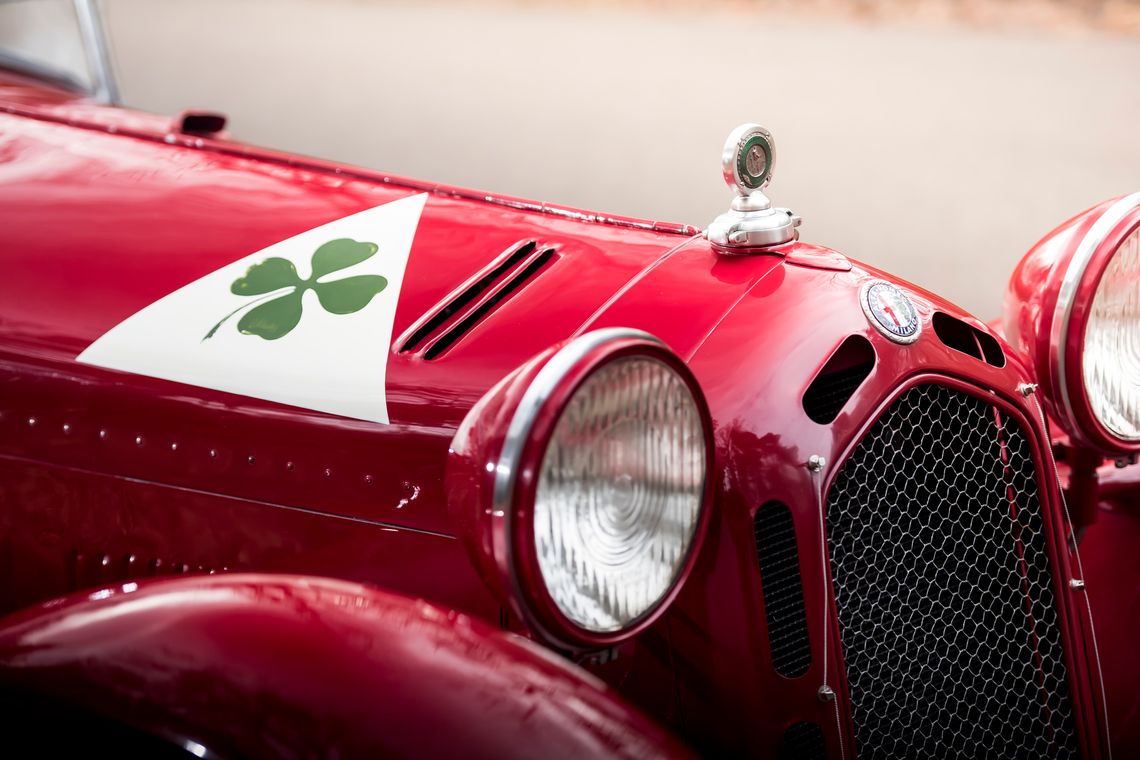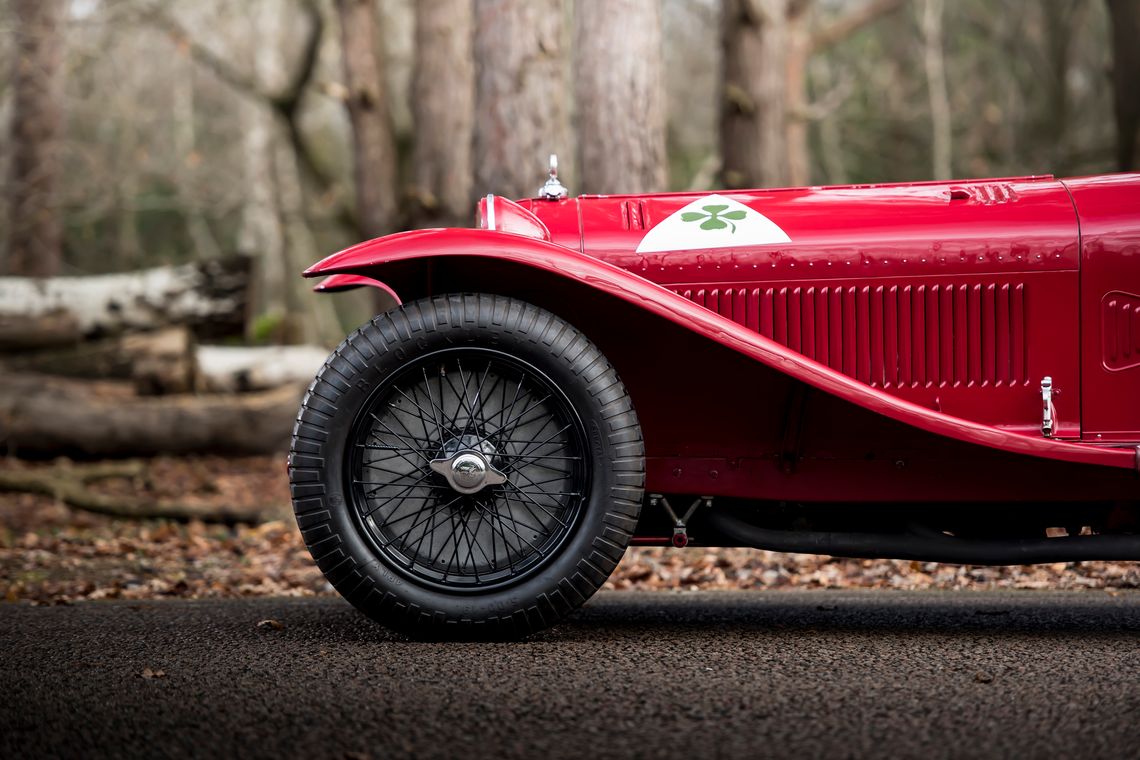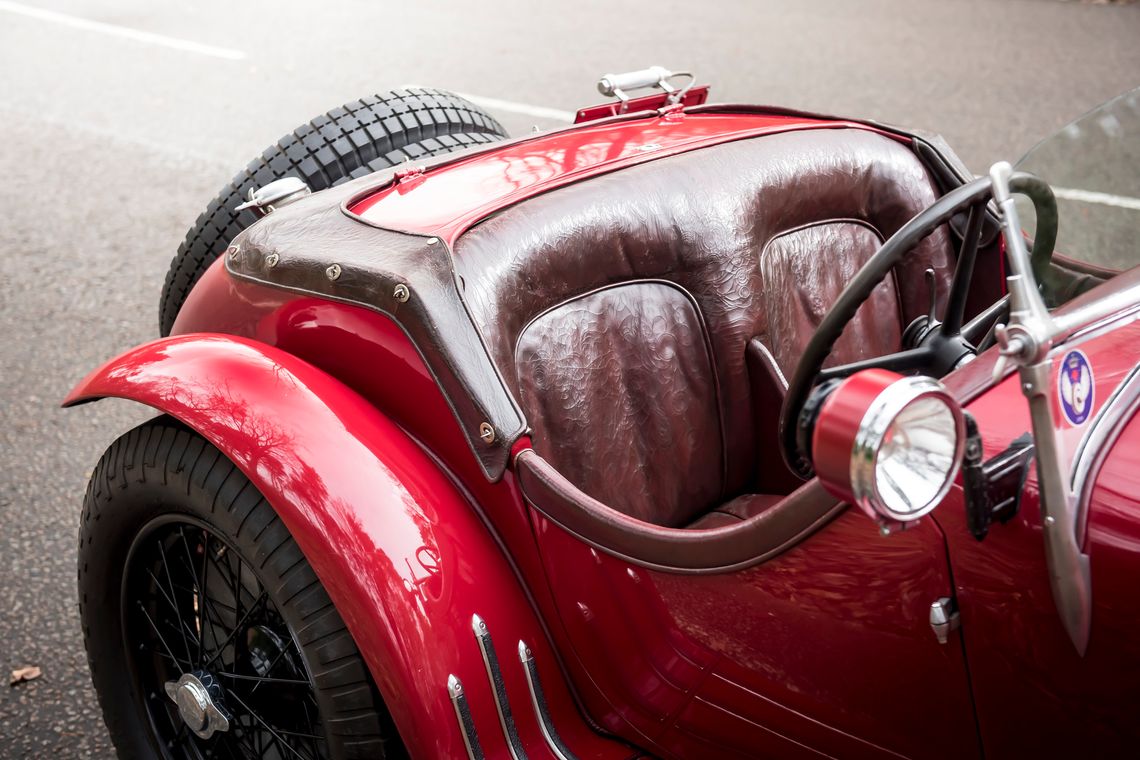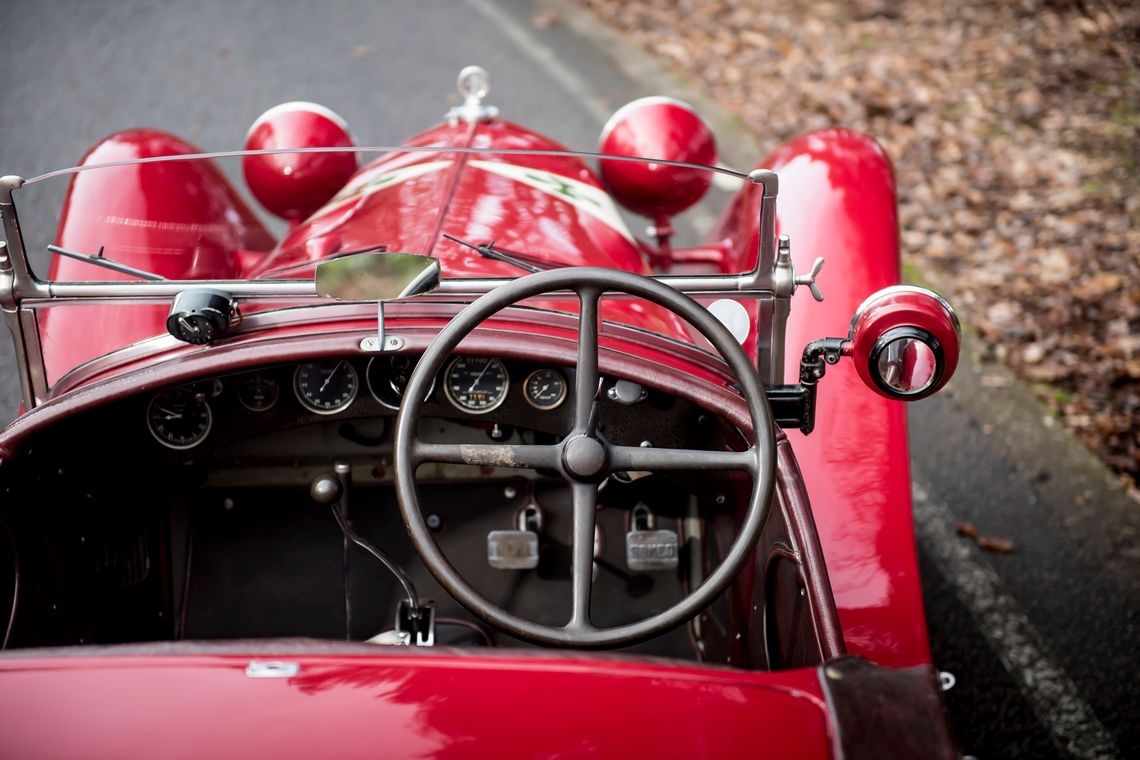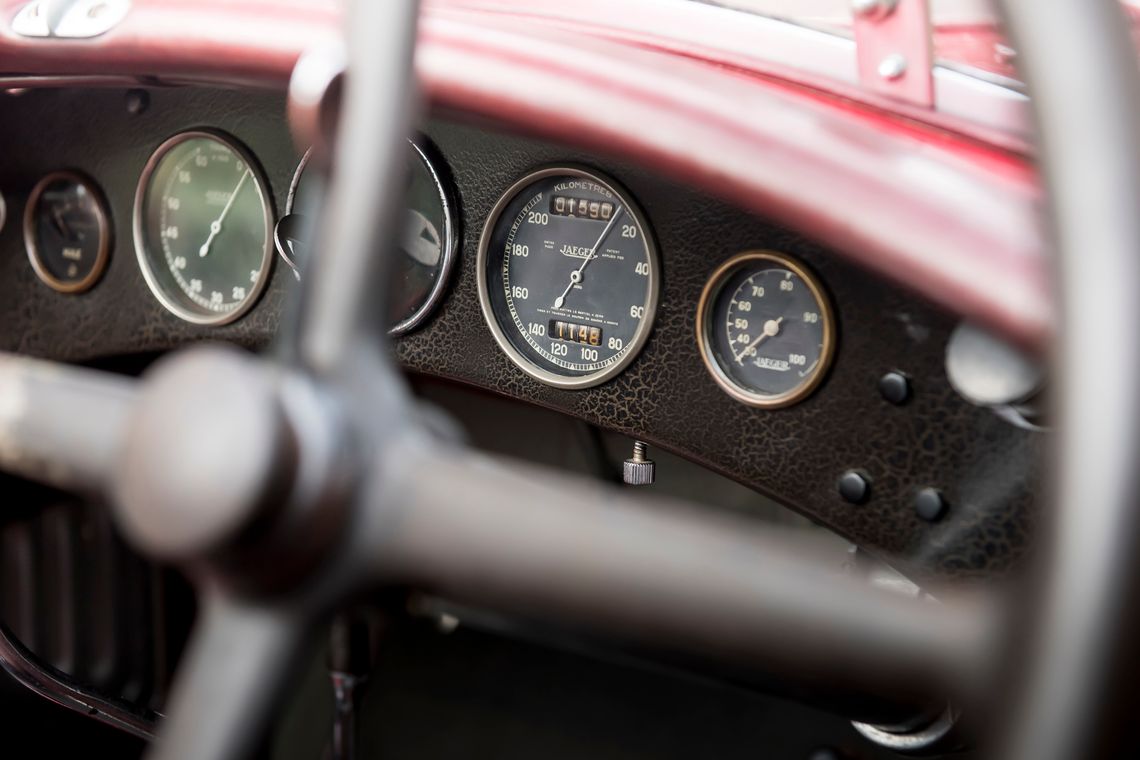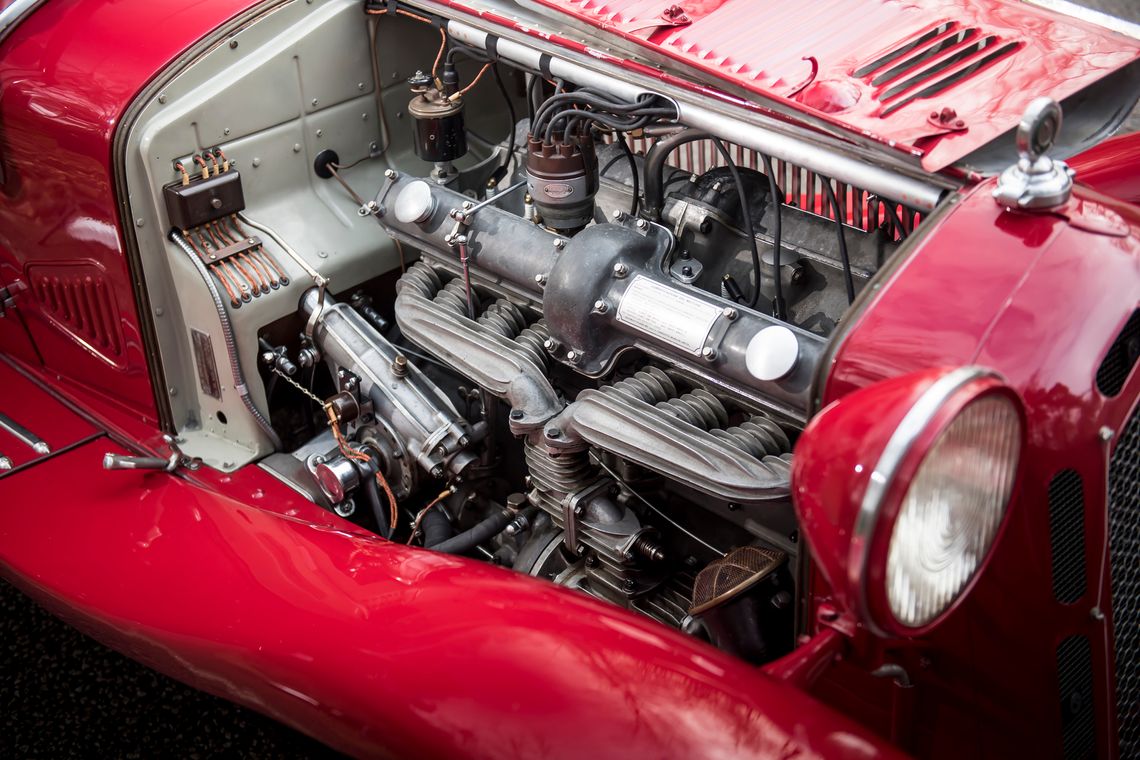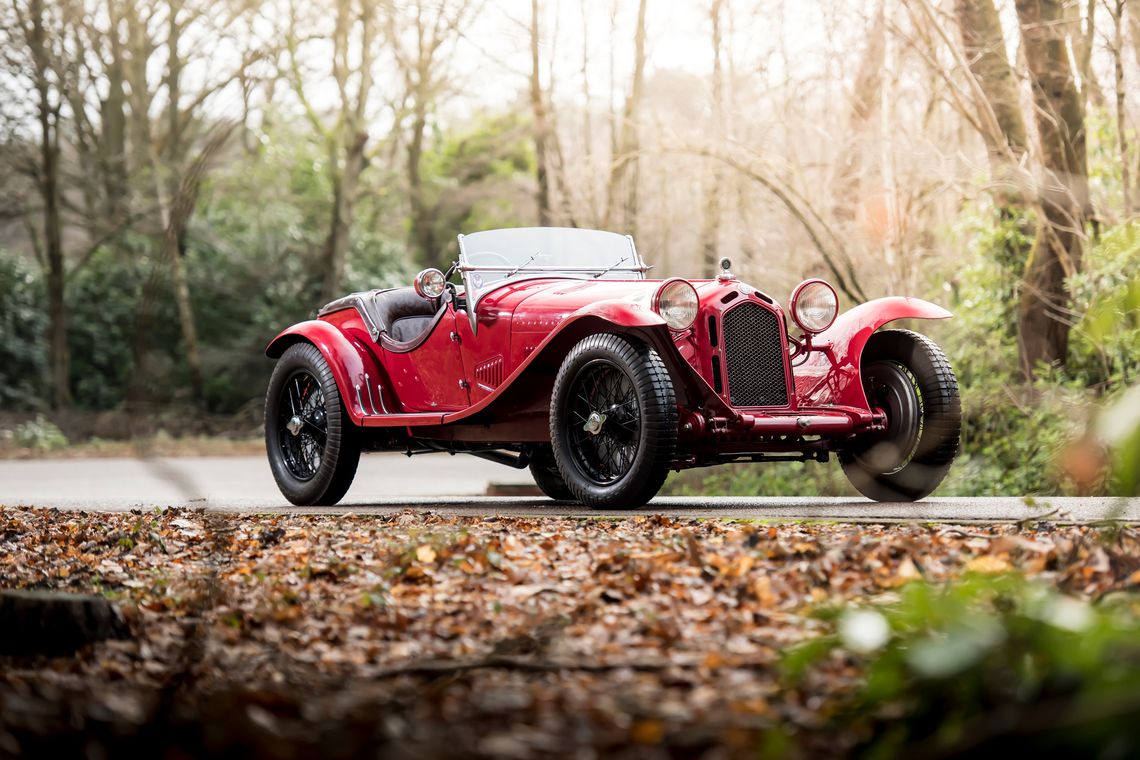
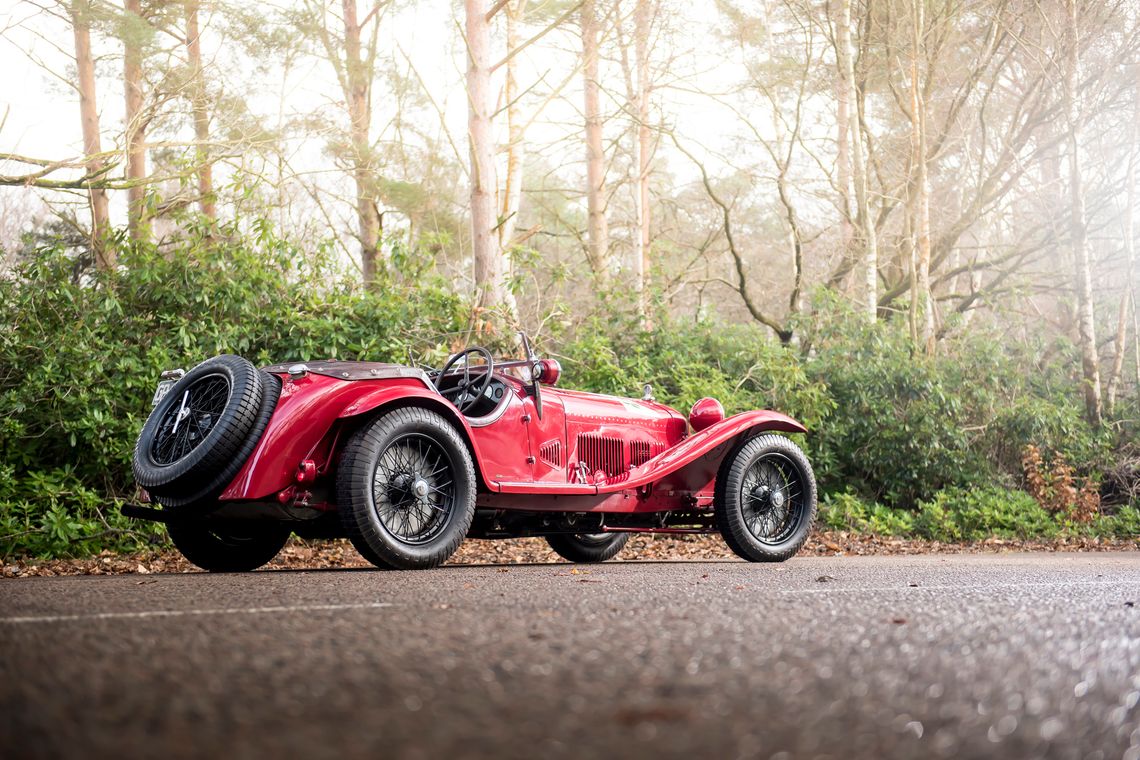
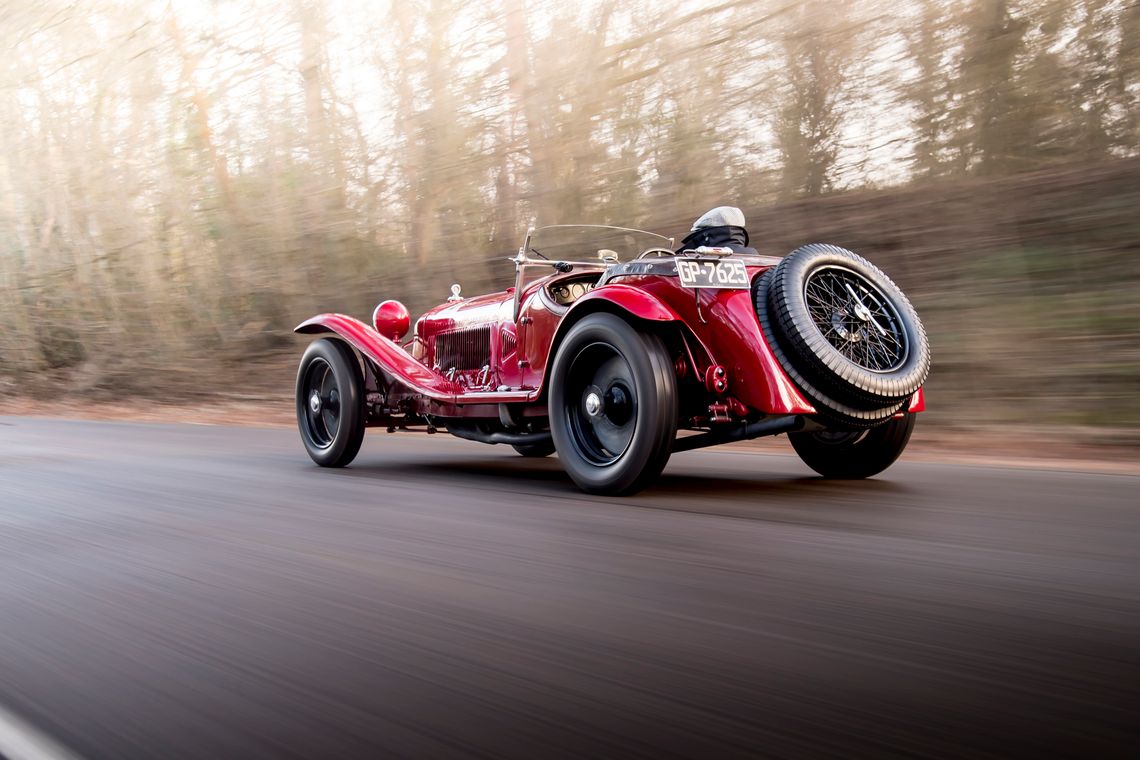




The Alfa Romeo 8C 2300 is regarded by automotive connoisseurs as the finest pre-war sports car, a legendary design that’s talked about in the same breath as the Ferrari 250GTO and the McLaren F1.
Conceived in 1930 by Vittorio Jano, the brilliant Torinese engineer, as a development of his giant killing 6C 1750 classic, the thoroughbred 8C featured a new supercharged straight eight that pushed performance into another league.
The short chassis spiders are the most desirable model of the 8C’s limited 184 production particularly those bodied by Zagato, the famous Milanese Carrozzeria. Famed for sleek, lightweight designs, Zagato were Alfa’s first choice for the first 8C sports racers. This historic first series 8C chassis ‘2111006’ is one of the first ‘Corto’ Spiders and features the beautiful low radiator and high wing styling that brilliantly matched the thoroughbred engineering under its hand built, aluminium form.
In its debut year, this great 8C was closely linked with many Alfa Romeo legends including designer Jano, race team manager Enzo Ferrari, and the fastest Italian aces of the era headed by Jano’s favourite, Tazio Nuvolari. During development for a packed competition schedule, this early 8C was no doubt tested by all the trusted team including Ferrari himself who drove his last ever race in a sister 8C Zagato team car at the 1931 Circuito delle Tre Provincie.
Although prepared to debut in the 1931 Targa Florio, it’s believed chassis ‘2111006’ wasn’t ready. At the demanding Sicilian road race Nuvolari won in an identical 8C for the Alfa Corsa team after Jano instructed front wings to be fitted before the start of the wet, muddy race. After 9 hours racing a determined Nuvolari cut back the advantage of Varzi’s red painted Bugatti.
Grand Prix races were demanding enduros in the early 1930s, and the freshly finished ‘2111006’ was taken to Spa for the Belgium Grand Prix which over 88 laps of the fast 9.25 mile Ardennes road circuit was 10 hours long. Alfa Corsa entered three new 8Cs with Nuvolari teamed with Baconin Borzacchini, and Campari sharing with Goffredo Zehender. ‘2111006’ was allotted to the veteran Ferdinando Minoia and Giovanni Minozzi. Born in Lombardy in 1884, Minoia started racing in 1904 with an Isotta Fraschini, and excelled in road races including winning the 1927 Mille Miglia for OM.
A gripping Alfa v Bugatti duel played through the long race with Nuvolari setting the pace but the quicker pits stop for Bugatti thanks to the easy removal of combined wheel/ brake drums saw the talented English ace William Grover-Williams’ Type 51 catch Nuvolari on the last laps. Minoia finished an impressive third in ‘2111006’ and capped his distinguished career at Spa by winning the driver’s championship for Alfa.
In early August Ferrari’s team headed to the Coppa Ciano, a long established road race on the Tuscan coast which attracted over 100,000 spectators around the narrow, hilly 20km road course. As well as a magnificent trophy donated by the Italian Navy hero Costanza Ciano, the winner of the large capacity class took home 215,000 lira prize money. Again the main rivals were the ‘works’ Bugatti Type 51s of Archille Varzi and Louis Chiron, the Monegasque making his debut at the tough road course.
The event was the climax of a week-long speed festival which included motor cycle races. Nuvolari opted for the Coppa Ciano rather than the Avusrennen staged the same weekend, and was entered in chassis ‘2111006,’ one of four 8Cs prepared by Scuderia Ferrari. With Zagato body featuring distinctive Monza radiator cowl and lighter cycle wings, it carried the registration MO5201 which identified it through its life with the legendary Modena equipe. On the long bonnet it proudly carried Alfa’s ‘Quadrifoglio’ team motif.
With 42 cars starting in groups of three at one-minute intervals, overtaking the slower cars was particularly challenging at this tight, hilly course with unforgiving stone walls bordering the serpentine curves. In contrast the return to Livorno along the coast included one of the most historic roads in Italy, the Roman Via Aurelia, a name designer Jano would adopt for his classic post-war Lancia.
The area was proud of the event and as well as resurfacing and taking up the treacherous tram lines, a revised start/finish area in Ardenza Mare featured 25 new pits and impressive grandstands. On a hot August afternoon, the first line of three small Fiats whizzed off as the faster cars readied at the back, both Varzi and Chiron starting before Italy’s most famous ace in the second batch.
On the first lap Nuvolari was held up by slower entrants and at the end of the opening circuit he was only fourth, 11 seconds behind the hard charging Varzi’s Bugatti. But the Mantuan drove a sensational second lap, gunning the 8C around the narrow undulating course up to Salvolano and Castellaggio. When he blasted back down the start/finish straight the Alfa was up to second having cut Varzi’s lead to 4 seconds. Even after his rival was delayed by a puncture, Nuvolari’s pace didn’t ease as he posted faster and faster laps in this car with a remarkable 4mins 8secs on his fifth circuit.
With the race in hand for the Italian hero, the loudspeakers announced that Nuvolari had crashed and damaged his car. After reports that Chiron’s Bugatti has passed a slowing Nuvolari coming down the mountains, all eyes in Ardenza Mare were on the finish line. Tension rose as the Bugatti appeared first, but after a seemingly eternal 14secs, the Alfa roared into view and a huge applause erupted from the crowd. As he had started a minute behind Chiron, the Flying Mantuan had won by 44 seconds. Giuseppe Campari, who’d switched the monster Alfa Tipo A 12 cylinder for a 8C finished fourth with Franco Cortese sixth. No doubt Enzo’s team partied hard in Livorno with Campari, oiled by his favourite wines, singing arias into the early hours. Nuvolari would win the Coppa Ciano an impressive five times.
The biggest event for Scuderia Ferrari in Italy was the Mille Miglia, the epic non-stop road race from Brescia to Rome and back. After the shock result of Rudi Caracciola’s Teutonic Mercedes-Benz SSK victory in 1931, the first for a non-Italian marque since the event started in 1927, Enzo was under strong national pressure to reclaim the Mille Miglia for Italy and Alfa Romeo. A red car had to win and even German ace Caracciola was secured for the team. Designer Jano would regularly visit Modena to discuss improvements to the 8C as well as going out on test runs and trying the cars himself.
As such, during the winter/spring of 1931/32, the rapid 8C ‘2111006’ was uprated with the latest new parts including shorter Monza type front springs to sharpen the handling and improve braking.
Including works team cars, and wealthy privateer entrants, eleven Alfa 8Cs were entered for the 1932 Mille Miglia. The course ran west from Brescia to Cremona before heading down to Bologna and then over the famous passes of La Futa and Radicofani on route to Rome. Chassis ‘2111006’ was prepared for Pietro Ghersi, a respected ace who like Nuvolari, and Taruffi, had switched from motor cycle success to cars with impressive results including the 1930 Spa 24 Hours. For his riding mechanic, Ghersi was given the best, Giulio Ramponi no less. The Milan born engineer was close to Jano from the glory days of the Grand Prix P2 and had ridden with all the greats including Campari on two Mille Miglia victories. Ramponi later went on to manage Whitney Straight’s team and develop Richard Seaman’s famous black GP Delage.
The Alfa team arrived in style at Brescia with Ghersi’s 8C joining a nine car Scuderia Ferrari convoy to the event led by a handsome Alfa 6C 1750GTC. On route they stopped for Dr Ferruccio Testi to take a happy team photo around ‘2111006’ with a proud Enzo Ferrari and Baroness Avanzo centre stage.
At 11.03 in the morning, the fastest cars were the last to leave Brescia with Ghersi and Ramponi the first of the glorious sounding 8Cs to leave the starting ramp. With triple headlights fitted with red domed covers, and lightweight wings, ‘2111006’ looked more purposeful than the coachbuilt Touring team cars. On dry roads, Ghersi set a determined pace and over the Futa Pass left a dramatic trail of dust for following entrants but frustratingly he retired before Rome. Story has it Ramponi had taken a stint at the wheel and lost control, the damage forcing retirement. When the ‘2111006’ was restored in the 1950s in Belgium there was no evidence of crash damage, and it’s possible the chassis was uprated after the Mille Miglia. This would explain why there are no front oil tank mounts, a feature of early frames. Alfa 8Cs dominated the event with Baconin Borzacchini winning from Count Carlo Felice Trossi, president of Scuderia Ferrari, in another Zagato bodied Spider.
The 8C then headed to North West Siciliy for the Coppa Messina in May for another demanding road race. Again Ghersi drove ‘2111006’ taking an impressive victory around the 52km circuit heading an 8C 1-2-3 ahead of Antonio Brivio and Guido d’Ippolito.
At some point the well worn lightweight body was replaced in the summer of 1932 with a beautiful Zagato spider to match Trossi’s car. Although this stylish coachwork was probably in preparation for selling, ‘2111006’ competed once more with the Scuderia at the Coppa Gran Sasso d’Italia. The spectacular 500km road race in the Abruzzo Apennine region involved two laps around the Corno Grande mountains which Piero Taruffi won from Carlo Gazzabini proving the 8C’s continued dominance.
As Ferrari’s team focused on running the new Tipo B Monoposto, the older team cars were sold off to eager privateer Italians. The 8C was still the fastest Italian sports car, and in November ‘2111006’ was reregistered GR1961 (the Grosseto region of Tuscany) for new owner Jacques ‘Giacomo’ De Rham who sold it on in early March to the Alfa dealership in Rome. It’s believed the 8C may have been loaned for the 1933 Mille Miglia where 17 were entered headed by the Scuderia Ferrari Zagato bodied team car of winner Nuvolari.
In May ‘2111006’ was reregistered ROMA 35072 for new owner Giuseppe de Filippis, and located on Via Savoia close to Villa Borghese park, the 8C Zagato spider must have looked and sounded fantastic roaring around the Italian capital.
Still a competitive machine for the Mille Miglia, de Filippis was persuaded to sell just days before the 1934 event by Pietro Santi. On April 8 ‘2111006’ was back on the Brescia starting ramp with number 54 for the VIII Mille Miglia with Lelio Pellegrini as his co-driver. Despite now being four-years-old, the Zagato spider was still fast and clocked in at the Rome control in 6 hours 30 minutes. Up ahead the hot Brianza bodied Monzas of Nuvolari and Varzi were battling for the lead with Varzi eventually winning in his 2.6 litre team car in a new record of 14 hours 8 minutes but frustratingly Santi and Pellegrini retired.
After the Mille Miglia Santi sold ‘2111006,’ and during the 1930s it changed hands several times to various Milanese enthusiasts before Felice Bonetto, the fearless Italian ace and ’52 Targa Florio winner, acquired ‘2111006.’ A future Grand Prix driver for Alfa’s fabulous Alfetta 159, and a member of both Scuderia Ferrari and the Lancia works team, Bonetto like many drivers supplemented his income as a car dealer. For the first time ‘2111006’ was sold out of Italy to Paul Decker, a Luxemburg dentist. From 1936 to 1946 Decker kept the 8C in fine fettle entering local hillclimbs, and securing its survival by hiding it away from inquisitive Germans during WW2.
Jean de Dobbeleer was one of the first specialists to appreciate the worth of fine pre-war cars and as well as famously buying and selling many Bugattis, his Brussels garage also stocked Hispano Suizas and Italian exotics. In 1956 de Dobbeleer acquired ‘2111006’ and, after a rebuild, sold it to America for $520 to Ed Roy, a Boston based Alfa enthusiast.
The 8C remained in the USA until the late 1970s, Roy eventually selling ‘2111006’ to Ted Pratt in Connecticut before the well known English Alfista Rodney Felton bought the car and shipped it complete with body to England where he set about a full mechanical rebuild. A superb engineer, and old school enthusiast who restored and maintained his cars, Felton soon had ‘2111006’ back to dramatic fettle.
Registered GP 7625, this fabulous Zagato spider was a regular in Vintage Sports Car Club events to which Felton always drove to meetings. To protect the original Zagato body, Felton built a Monza alternative which he fitted for track events including the VSCC’s Williams Trophy where again the great Alfa v Bugatti rivalry was replayed as the passionate Alfa enthusiast took on the fastest Type 51s to two victories in 1980s. Felton also entered in the 1983 Grand Prix de Historique organized by the Hon Patrick Lindsay where this talented driver relished the chance to run in the tracks of his hero Nuvolari. In 1986 Felton organized an all pre-war Alfa race for the VSCC and ‘2111006’ featured in the amazing grid of 8Cs and Tipo B Monopostos as a tribute to the great designer Jano.
When Felton started competing with a Tipo B Grand Prix racer, his prized ‘2111006’ reverted to original Spider bodywork which he regularly drove on the road, it’s dramatic performance always upstaging modern sports cars.
Felton’s determination to prove his 8C was faster than a rival Bugatti Type 51 led to a performance test against his friend Geoffrey St John which featured in Classic & Sports Car magazine (April 1987) and Automobiles Classique (June/July 1987). The 8C delivered startling performance figures with 0-60mph in 5.8secs, and 0-100mph in 15.5secs, the two thoroughbreds running neck and neck down an English airfield runway to 120mph.
In 1992 Felton decided to sell ‘2111006’ to fund exciting new projects including an Alfa 8C 2900 and a Ferrari 250 Testa Rossa. The lucky new Californian owner was Bruce Vanyo, another passionate Alfa devoteee, who part traded a Bugatti T55 to get his dream car. Vanyo had the Alfa detailed by top specialists including refitting the original Zagato wings which he sourced from Ned Reich. The Californian also enlisted Alfa 8C guru Simon Moore to research ‘2111006’ in depth, and the famous Spider features extensively in the English historian’s award winning book The Legendary 2.3 including a colour gallery confirming its significance. Vanyo also drove ‘2111006’ extensively including racing it at the famous Monterey Historic Races in 1992.
After acquisition in 1994 by Alain de Cadenet, one of the best known Alfa connoisseurs, chassis ‘2111006’ returned to Europe where in 1996 it became one of the stars of a private Dutch collection together with one of the greatest Ferraris, the highly original 250 Testa Rossa ‘0704.’
This great Alfa was dispatched to foremost 8C specialist Neil Twyman Ltd where it received a detailed and sympathetic restoration to its present stunning condition. In 2015 ‘2111006’ was invited to the Cartier Style et Luxe at the Goodwood Festival of Speed where it wowed judges to win a special class for supercharged pre-war sports cars.
Alfa Romeo 8C Short Chassis Zagato Spiders are very rarely offered, particularly one with such illustrious competition history and direct links to Jano, Zagato, Ferrari, and Nuvolari. Fiskens are proud to offer ‘2111006’, one of the greatest sports cars of all time.
